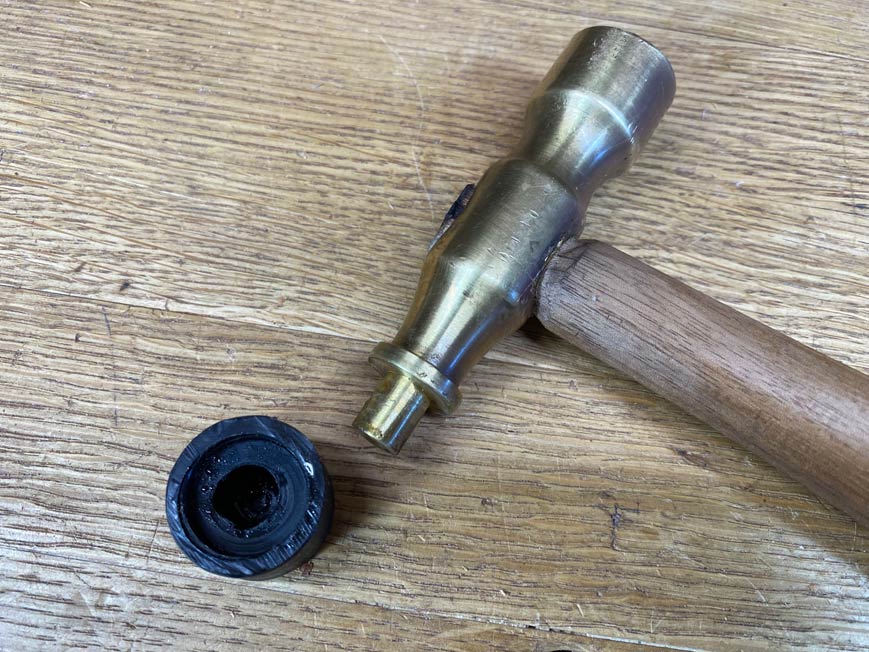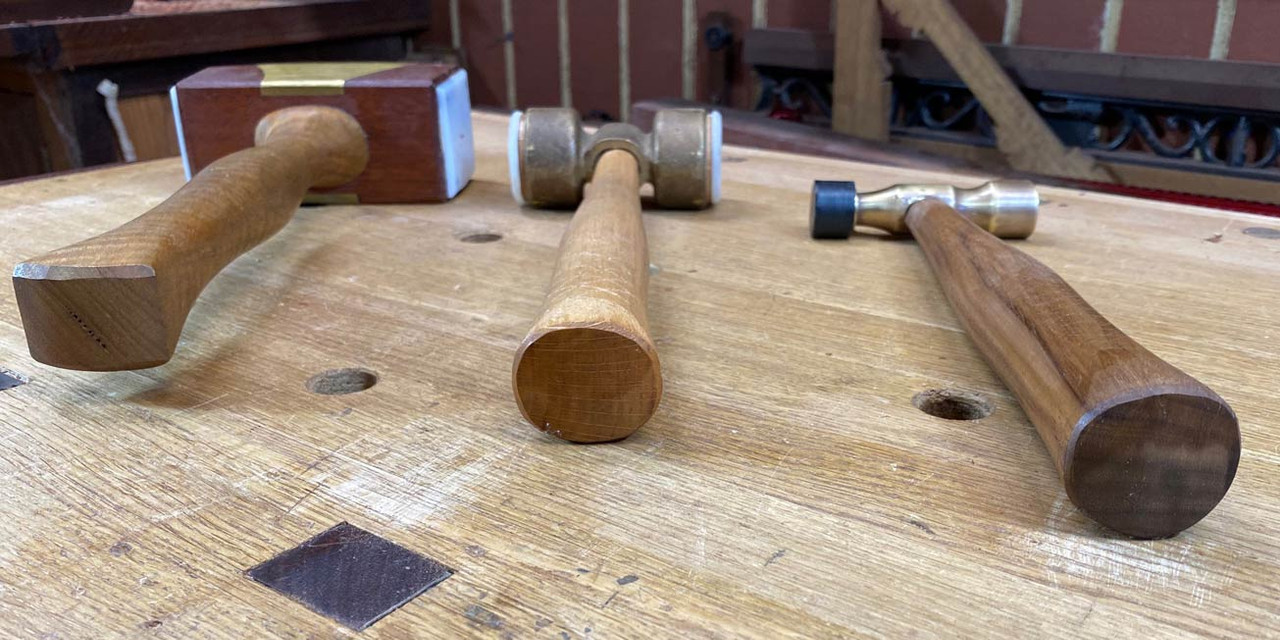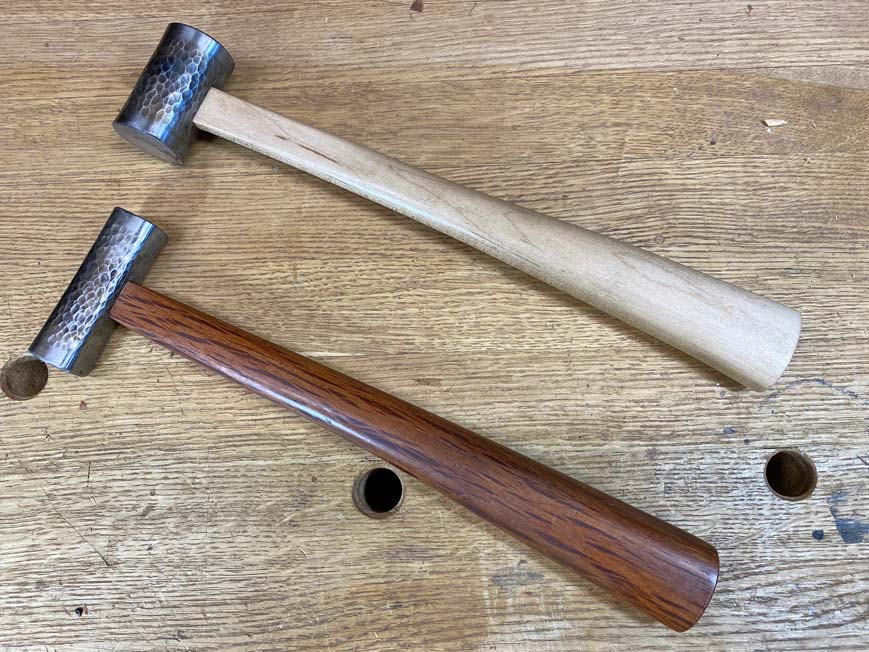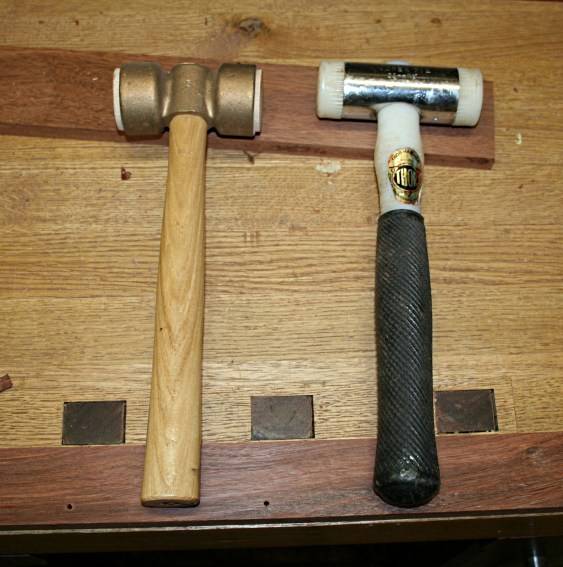 Needs Pictures: 0
Needs Pictures: 0
Results 1 to 15 of 43
-
27th February 2022, 02:59 AM #1
 Designing chisel mallets and hammers.
Designing chisel mallets and hammers.
Mallets and plane hammers are relatively easy to make, and often one of the first tools made by many starting out. But what makes for a good chisel hammer? I have seen some woodworkers wacking a chisel with a lump of wood. Some prefer a claw hammer.
Once upon a time I purchased a plane hammer with a head made of brass and Cocobolo. It had a long, narrow and straight handle, which stayed in my hand as long as I gripped it tightly. The Cocobolo head cracked, and the hammer went to live on a shelf.
A few weeks ago I resurrected this hammer, replacing the Cocobolo with UHMW, and fitting a new handle. This hammer is now my go-to for wood handled chisels which are not reinforced by a hoop, when chopping dovetails. It has inspired me to comment on what I look for when making a chisel hammer. This is the hammer ...

I love UHMW and use it on most of my chisel hammers. It is elastic enough to avoid damaging any wooden surface, but hard enough to offer good feedback. It is available in the form of cutting boards, and I have some from salvage yards. This head was turned on my wood lathe ...

The Black Walnut handle was rough turned on a lathe, and then shaped with a drawknife and spokeshave. The end weight was 12oz/350g.
The handle needs to be seen in three-dimensions. It is oval as well as recessed to fit a hand. The recess prevents the hammer flying off into outer space, while the oval makes it fit the hand.

The length of the handle is the third dimension - the shorter, the less impact; the longer, the greater impact.
This is comfortable ..

A really heavy hammer such as the one on the left (38oz/1070g) is intended for morticing into hard wood. Thus has a double recess and allows it to be used in a choked position. I rarely use this hammer now days as it it simply too heavy.
It has been replaced by the middle hammer ...

This began life as the Veritas Cabinetmaker's Mallet. UHMW was added to the faces (epoxy and nails, for those asking), and a new handle made from Hard Maple. The brass head helps it reach 23oz/655g. This is a great hammer for morticing.
Fruit woods make good handles. Avoid run out, look for long grain. Some of the worst handles I have had are hardwoods, such as Jarrah - just to brittle with its short grain.
There is no doubt that a small and heavy head has advantages over another hammer which weighs as much but has a large head. Further, my preference is a flat face, rather than the rounded edge of a carver's mallet. I know some prefer the latter, but in my experience it waste energy and requires more care to avoid a glancing blow. The large mallet, above, was styled after a traditional joiner's mallet, and the head weight increased with brass infill. The aim was to find a way to increase weight in a smaller head. In the end it just was too heavy. One does not need to apply brute force.
I believe that the ultimate expression of the chisel hammer is the Japanese gennou. These are designed for working with hooped Japanese bench butt chisels, or oire nomi. I have two, one 13oz/370g and the other 16oz/450g.

The heads are hardened steel on the outside with softer steel internally to act as a shock absorber. These were made by Tenryuu.
I shaped these handles in a traditional style. They curve as well as taper. This is not as clear in this photo, but more so in the last picture. The curve influences the striking angle and the taper safeguards the grip.

Regards from Perth
DerekVisit www.inthewoodshop.com for tutorials on constructing handtools, handtool reviews, and my trials and tribulations with furniture builds.
-
27th February 2022 02:59 AM # ADSGoogle Adsense Advertisement
- Join Date
- Always
- Location
- Advertising world
- Posts
- Many
-
27th February 2022, 10:42 AM #2

Funny how something as basic as a mallet can occupy our minds; they are a subject I've spent a bit of thought-time on too. We're pretty much on the same page 'cept I still prefer a wooden head (& I think my chisels do, too). There are quuite a few suitable woods round my way that make good mallet heads. I look for non-splitty woods with a density >1), which allows a compact head of around the 400g mark. That's a head weight that I too find a very comfy fit for a dovetailing & similar general-duties mallet. For heavy mortising, I don't go as extreme as 32oz (~900g!) something with 500-600g head does a good job for me. But preferred head-weights will be a personal choice & depend on your physical strength & endurance.
Handles are a personal taste, but I too like the shape used on claw-hammers & the like. I turn the profile shape on the lathe then blend it into final shape with a rasp as described here.
A well-shaped handle and a wooden head do a very good job of absorbing shock, but you also need to learn the art of loosening your grip on impact, then grasping it again for the next lift - this will almost completely eliminate jar in your wrist or arm & you are also less likely to break handles. I learnt the importance of this technique as a teenager when swinging a sledgehammer all day to split fenceposts. A handful of blisters & painful wrists & elbows was the cost of getting it wrong!
Making your own bashers is a fun project & material costs can be negligible to zero, hardwood scraps are everywhere you look. You will soon discover what you like, & a mallet that suits you to a tee is just so much more enjoyable to use...

Cheers,IW
-
27th February 2022, 11:50 AM #3
 .
.











- Join Date
- Feb 2006
- Location
- Perth
- Posts
- 27,793

Here's a selection of some of my mallets/hammers/whackers
Mallets.jpg
1 Cork and leather faced, WA Redgum for taking apart furniture
2 All Sheoak, general purpose
3 Sheoak Gavel , Wandoo striker - gift for work colleague
4 Brass and Al faced WA Redgum - light machinery use
5 Jarrah and WA Redgum - woodie plane setter
6 Large version of 2
7 WA Redgum lumpy (used on machinery) - I've destroyed the head - handle lives on on in #8
8 Rock oak head and handle from #7 , head also now falling apart
9 Brass hand Al headed luthiers fret setting mallet - made for Thomas Lloyd Guitar making School
10 close up of #4
11 Olive wood
12 Brass and Sheoak
-
27th February 2022, 12:55 PM #4

Bob, many thanks for posting these pics of your hammers. I hate to say this, but must since this thread is about design, that your handles are the very type that made me want to write this article!
 Sorry.
Sorry.
You do beautiful work, use gorgeous wood, and the result is most striking (pun not intended). While the hammer works - any lump works - these straight handles encourage one to grip more tightly and would lead to fatigue with extended use.
I am not advocating that others use my designs - the topic is about understanding what works better, rather than settling for a less appropriately designed tool.
One of my favourite hammers is this one on the right (on the left is the original Veritas handle - not bad at all).

Regards from Perth
Derek
Visit www.inthewoodshop.com for tutorials on constructing handtools, handtool reviews, and my trials and tribulations with furniture builds.
-
27th February 2022, 01:56 PM #5
 .
.











- Join Date
- Feb 2006
- Location
- Perth
- Posts
- 27,793

Derek - I agree some of my early (made in 2006/7) squarish handles (eg 1,2, 6,7,8 ) are not that good.
Even though it's still a tad square, #4 still feels pretty good to me and even though I don't use it that often it's the one I use more than the others from that era.
Things improved somewhat when I got a lathe in 2008.
Of the mallets in the compilation pic, the only one I've made in the last 12 years is the Olive wood carvers mallet.
These days the most likely hammer I'm swinging is a welding slag chipper, or machinist hammer for some sort of a short term brutal process.
-
27th February 2022, 02:01 PM #6

Bob, all that makes sense when one "swinging at welding slag". However, driving a chisel it is not about brute force, but usually about finesse. This is the very essence of Japanese woodworking and the relationship between an oire nomi and a gennou. I also have a memory of watching David Charlesworth tap-tap his chisel. A 12oz hammer works so much better for me when slicing away the waste from a dovetail socket. A smaller, heavier head requires less effort and has more control than a wooden head which needs to be large to carry more mass.
Regards from Perth
DerekVisit www.inthewoodshop.com for tutorials on constructing handtools, handtool reviews, and my trials and tribulations with furniture builds.
-
27th February 2022, 03:46 PM #7

Can't let that one through to the keeper, Derek. Mass is mass so 12 oz of wood takes the same effort to lift & develops the same kinetic energy as it falls as 12 oz. of steel unless physics is different in W.A. I guess you could argue that the larger surface area of the wooden head makes for more air resistance, but I think we'd be looking at some pretty small numbers splitting that particular hair!
Of course, less dense = more volume for the same mass, and I will certainly agree that a large & bulky mallet head makes a clumsy instrument. But a 400g wooden head (~14oz. in old money) which is around my prefered head weight for a dovetailing mallet isn't a very bulky item made from something with a SG >1. I can't go down the shed atm (the sky has just broken open & I'm busy loading the ark) to run a ruler over my favourite basher, but it's around this size:
Olive handle.jpg which from memory has a face about 50 x 55mm and would be ~100mm long. IIRC, this head was closer to 450g, which is a bit over my 'sweet spot' for a dovetailer, or at least the very upper limit, but some big strong young fella would probably find it too dainty.
The handle is 'native' olive, btw, (Olea paniculata) a lovely wood to turn & makes a superb handle....
Cheers,IW
-
27th February 2022, 04:55 PM #8

Been thinking about hammers & heads & weights & effort & I think it would be exceedingly difficult to come up with any true generalisations that would work, even for one person, let alone everyone. Particularly as I reckon given that I think much of the variation in choice of pursuader size boils down to personal choice & what we are used to.
F'rinstance, when peening metal, I use either an 8 ounce (=226g) or a 4 oz (~113g). The smaller hammer is really only good for very small stuff or tight spots, because paradoxically, it's actually more tiring to use than the 8oz. That's because it takes many more blows from the smaller ball to move the same amount of metal. The rate at which I hammer with the smaller hammer isn't that much different than the rate for the larger, because I'm holding the handle quite high up on both, and over a limited range, the distance from hand to hammer head is the prime determinant of the hammering rate in this sort of exercise.
In other situations, a lighter hammer/mallet can be less tiring to use than a large one. This would be the situation when dovetailing, for example. With softer woods (i.e. softer than jarrah! ), & after sawing out all but ~1mm of the waste, it takes very little effort to slice that last sliver off - with some woods like camphor laurel it can be done with hand pressure alone so tap of the mallet is all it takes. So I tend to favour the lightest one I have for this job. In fact, I was using the ridiculously dinky mallet I made for my miniature tool chest when fitting out the internal compartments & was surprised at how adequate it was. On the strength of that, I just finished making some small mallets half the size & a bit more than my regular user, to play with. A quick try-out indicated at least one could become a regular user.
), & after sawing out all but ~1mm of the waste, it takes very little effort to slice that last sliver off - with some woods like camphor laurel it can be done with hand pressure alone so tap of the mallet is all it takes. So I tend to favour the lightest one I have for this job. In fact, I was using the ridiculously dinky mallet I made for my miniature tool chest when fitting out the internal compartments & was surprised at how adequate it was. On the strength of that, I just finished making some small mallets half the size & a bit more than my regular user, to play with. A quick try-out indicated at least one could become a regular user.
As I get older & feebler, I'm moving more & more into small stuff - perhaps a timely move since I now have 3 grand daughters, and one (furnished) dolls-house on order already. So as long as my eyes hold out for a few more years, it seems nature is asserting itself in an orderly way......

Cheers,IW
-
27th February 2022, 05:11 PM #9

I’m enjoying this discussion; on my “to do” list is to make a lightweight (1/2lb-ish) precision tapping implement for setting the irons in wooden moulding planes. I want to have one head having a brass insert for striking the tang on the iron and the other with a wider face made from leather or UHMW for tapping the body; similar to your plane hammer.
I spent a fair amount of time swinging ball pein hammers in my yoof; I also much prefer the oval cross-section/recessed handles made from wood. Whereas I can comfortable swing one of those until my arm gets tired my more modern fibreglass and rubber handled claw hammers will raise sore spots as well.Nothing succeeds like a budgie without a beak.
-
27th February 2022, 06:26 PM #10
 .
.











- Join Date
- Feb 2006
- Location
- Perth
- Posts
- 27,793

In 2006 I bought this 770g Douglas framing hammer in the US.
Whoever designed this hammer really though about design.
Excellent balance.
The flattish top and sides enables one to get right into corners.
The side nail puller is brilliant
The head has a nail magnet clip so it can be used one handed.
The handle is one of the best of any hammer I have used. It has a slight tapered lengthwise, oval cross section profile, but the wider sides have slightly raised (half mm) full length flat sections which feels odd at first but then you release it reduces twisting.
The integrated handle-head structure is made such that the top wooden part of the handle likely to strike something hard is protected by metal and would be very hard to break.
Doughamm.jpg
Now I'm not saying I use this on small chisels (BTW I hardly ever use chisels) but it shows that someone has really thought about whats needed in a framing hammer, especially the handle.
-
27th February 2022, 06:28 PM #11

Ian and CT, I think that we would agree that the ideal hammer has enough mass to exert enough force with the maximum control and minimum effort demanded. Of course, this is an ideal and everything is a compromise.
CT, let's take that plane hammer first, as the one I have may be just what you are seeking, and it also goes in part to respond to Ian's earlier comments.
Jarrah handle, tapered, into a 8oz brass head, with UHMW on one side. I have used versions of this for about 20 years ...

I used this on all my woodies, HNT Gordon being the main design, but also moulding planes. The handle is slim (to keep the weight down), but the taper helps keep a firm control.
One might imagine, when looking at the 12oz of the current chisel hammer featured above, that 8oz would be too light for driving Western dovetail chisels. But it is not - it was my go to for many years. Only when dealing with especially harder wood would I used the Veritas (23oz). This little dinky hammer has a small head, and this focuses the force exactly where you want it to go. There is more control, and the extra control compensates for less mass. The (new) 12oz mallet adds the extra desired mass into much the same size head.
It is not a coincidence that the smaller of the two gennou, at 13oz, is my preferred hammer for Japanese oire nomi. Again, the narrow focus of the smaller head may weigh the same as a larger, wooden mallet, but the small size offers such control and there is a feeling of increased power.
Like many, I turned many a carver's mallet when I first got a lathe. Big, small, a variety of shapes and angles. Eventually I lashed out on the Blue Spruce. What a beautiful and well-balanced carver's mallet this is. Not to mention indestructible. However, as time passed, it became apparent that this was not an efficient mallet.
So, Ian, in my opinion it is not simply mass that is important, but how the mass is utilised.
Regards from Perth
DerekVisit www.inthewoodshop.com for tutorials on constructing handtools, handtool reviews, and my trials and tribulations with furniture builds.
-
27th February 2022, 06:32 PM #12

Derek
I understand you are not keen on the round carver's mallet, but unless my eyes deceive me that is an awfully pretty carver's mallet you have in the array (with the black handle for extra excitement). Unless I am mistaken, right below it is yet another carver's mallet: This time one of those cute little egg hammers with a brass head?
Having said that I have about four carvers mallets. I really like them and after having them for somewhere around five or maybe six years I used one of them the other day for the first time: I couldn't find my traditional wooden mallet so in desperation I reached for one of the "carvers."

Just on a slightly different tack, I have some small chunks of that UHMW stuff, which may be suitable for hammer heads. I will have to get them out and check the dimensions. As your thread will undoubtedly attract all the sadistic woodworkers, if this material is of use I will be happy to supply it to people for the cost of postage. It may save chopping up cutting boards or is that cutting up chopping boards? Either way it may save some shekels. Postage would likely be $2.20 for some thing that weighs less than 125g and is a tad under 20mm thick.
Just throwing it out there in case it is of interest. I will post pix if you consider it has some merit.
Regards
Paul
PS: I have always admired your genous with the hammered finish: So appropriate .
Bushmiller;
.
Bushmiller;
"Power tends to corrupt. Absolute power corrupts, absolutely!"
-
27th February 2022, 06:39 PM #13

Thanks Paul
Our posts crossed, as I commented on the carver's mallet. It was made by Blue Spruce, and is resin-infused Maple with an African Blackwood handle. You cannot get them now in Oz as African Blackwood is banned by CITES.
Regards from Perth
DerekVisit www.inthewoodshop.com for tutorials on constructing handtools, handtool reviews, and my trials and tribulations with furniture builds.
-
27th February 2022, 06:42 PM #14
 Visit www.inthewoodshop.com for tutorials on constructing handtools, handtool reviews, and my trials and tribulations with furniture builds.
Visit www.inthewoodshop.com for tutorials on constructing handtools, handtool reviews, and my trials and tribulations with furniture builds.
-
27th February 2022, 07:05 PM #15

Such an understated tool , considering it probably was the first “EVER” tool, I can’t prove that, due too my ancestors being now carbon or diamonds but prove me wrong.
Seems its well over due for some love.
Nice hammers Derek.
Cheers Matt.
Similar Threads
-
Mallets
By Optimark in forum WOODTURNING - GENERALReplies: 10Last Post: 6th May 2021, 05:12 AM -
N.S.W. Hammers and Mallets
By Ruddy in forum WOODWORK - Tools & MachineryReplies: 5Last Post: 9th September 2020, 08:19 PM -
Mallets box
By Tomazelli in forum BOX MAKINGReplies: 2Last Post: 24th June 2012, 09:54 PM -
mallets
By nz_carver in forum WOODCARVING AND SCULPTUREReplies: 0Last Post: 3rd April 2009, 03:10 PM -
Mallets anyone?
By Wild Dingo in forum WOODTURNING - GENERALReplies: 31Last Post: 3rd May 2007, 02:11 PM



 Thanks:
Thanks:  Likes:
Likes:  Picture(s) thanks:
Picture(s) thanks: 
 Reply With Quote
Reply With Quote

